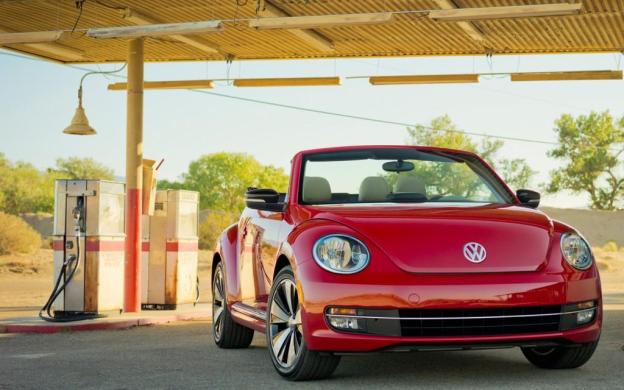 The retro-icon Volkswagen Beetle recently got a makeover, so it was inevitable that the Beetle convertible would follow suit. Like the hardtop, the new 2013 Beetle Convertible is no longer “New,” but its styling and mechanicals have matured.
The retro-icon Volkswagen Beetle recently got a makeover, so it was inevitable that the Beetle convertible would follow suit. Like the hardtop, the new 2013 Beetle Convertible is no longer “New,” but its styling and mechanicals have matured.
As with the old New Beetle Convertible, the top is soft (VW already has the Eos hardtop convertible) and piles up behind the rear seats just as it did on the original Beetle convertible. Other than that, the 2013 Beetle Convertible benefits from the same styling changes as its fixed-roofed sibling.
The same is true under the skin. The 2013 Beetle Convertible offers the same powertrains as the regular Beetle. These include: a 170 hp 2.5-liter inline-five, a 200 hp 2.0-liter turbocharged inline-four, and a 140 hp 2.0-liter turbodiesel inline-four. Both four-cylinder engines are available with either a six-speed manual transmission or six-speed DSG dual-clutch automated manual. The I-5 is only available with a six-speed automatic.
The 2013 Beetle will have the unique distinction of being the only diesel convertible sold in the United States, which should be a boon for green car enthusiasts who crave top-down motoring. It would also make a great advertisement for biodiesel conversions.
Other additions to the Beetle Convertible will enhance safety for passengers in this roofless vehicle. In the event of a rollover, two roll bars automatically deploy from behind the seats (hopefully they won’t go off by accident). The Convertible also gets driver and front passenger head-thorax airbags.
The 2013 Beetle Convertible natural rivals will be the equally cute, and equally retro, Mini Cooper Convertible and Fiat 500C. The Beetle has a definite size advantage over both cars, although its driving experience may be more laid back than a Mini’s.
The Beetle might have an advantage in straight line speed, though. A Mini Cooper Convertible does 0 to 60 mph in 8.9 seconds, while a hardtop Beetle 2.5L does it in 8.0. A Cooper S Convertible lowers the time to 7.0 seconds, while a Beetle Turbo hardtop does the same in 6.8 seconds.
However, the 2013 Beetle Convertible may be slightly slower than its hatchback counterpart, since convertibles are less aerodynamic and usually weigh more because of chassis bracing needed to keep their bodies rigid.
Styling will likely play a big part in any comparison between the three cars, but it’s difficult to say which version of a 1960s classic (1930s in the case of the Beetle, but no one likes to talk about that) will appeal to a given individual.
One area the Beetle will have a clear advantage in is fuel economy. Volkswagen says the diesel engine and manual transmission will be good for 41 mpg highway, besting the Cooper Convertible’s 35 mpg and the 500C’s 32 mpg.
Volkswagen did not announce pricing, but expect the 2013 Beetle Convertible to command a slight premium over the hatchback, which starts at $20,950. Appropriately, the drop-top Beetle will make its official debut in California, at November’s Los Angeles auto show.



